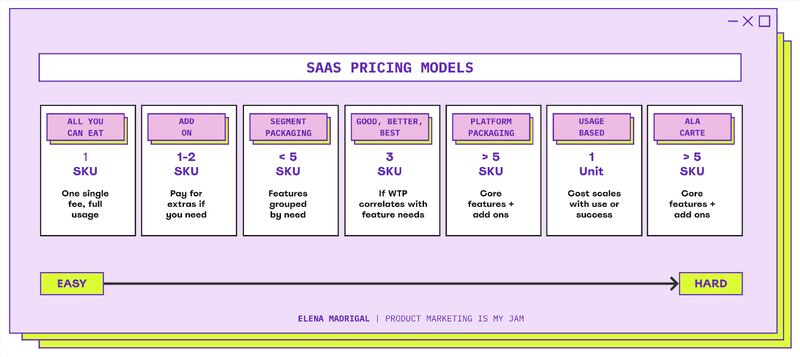Balancing Simplicity and Flexibility in Pricing Models.
What to consider when deciding on a pricing strategy that will serve both your customers and your business.

There’re a lot of things to consider when deciding on the right pricing strategy, pricing and value metrics, segments, packages, price points… But let’s keep it simple and start with some basic concepts before we just copy our competitors’ approach.
Last week at work, I put together a visual to explain different types of SaaS models and their tradeoffs. This was an introduction to a pricing and packaging exercise I'm working on.
All you can eat
Buffets are easy. You pay, get in, and then fill your plates with everything you want (or can). Same with All-inclusive vacations, you pay once, then indulge and come back home with some pounds that need shedding.
But easiest isn't always best. It's simple to set up one fee and unlock everything for everyone. But simple often means inflexible, lacking an upsell path. This approach doesn't consider different willingness to pay and the different value of each of your product's capabilities.
Some people will overuse features, leaving money on the table. Others may find the price too high for the few features they need and won't convert at all.
B2C Example: Spotify - Free users experience ads and limited skips, while premium subscribers enjoy an ad-free experience with unlimited skips and offline listening.
B2B Example: Slack - Offers a free version with basic features, while advanced capabilities like unlimited message history and enhanced security are behind a paywall.
Add on
A different approach? Put additional capabilities behind a paywall. Users can decide which add-ons they want to pay for. Continuing with the food analogies — my favorites! — Think of it like adding pizza toppings.
B2C Example: Apple's iCloud - Offers a basic subscription for storage, with additional charges for more storage, advanced features like iCloud Drive, or services like Apple Music and Apple TV+.
B2B Example: Dropbox Business - Provides a single fee for core storage and collaboration features, with additional charges for extra storage, advanced security features, and integrations with other business tools.
Segment packaging
Segment packaging is best when packaging for specific personas. Take LinkedIn, for example. Each package targets different segments: job seekers, sales people, recruiters, etc. Each has features relevant to specific needs.
That's different from the classic Good, Better, Best model.
B2C Example: LinkedIn Premium - Offers tailored packages for job seekers, sales professionals, and recruiters, each with unique features.
B2B Example: HubSpot - Provides different packages for marketing, sales, and service teams, each with tools specific to the needs of those roles.
Good, Better, Best
This one works best when there's a correlation between willingness to pay and added features. Usually, 3 packages work well—there's no place for Good, Better, Best, Bestest!
B2C Example: Zoom - Provides a free basic plan, a pro plan with more features, and a business plan with advanced capabilities.
B2B Example: Mailchimp - Offers a free plan with limited features, an essentials plan with more advanced tools, and a premium plan for large businesses with extensive needs.
Platform packaging
From here, things can get more complicated. More than five SKUs, plus add-ons, and per-usage calculations can be tricky. The complexity can impact your business, making it harder to manage, confusing customers, and increasing operational costs, so think well before getting there.
Amazon Web Services (AWS) - Users pay based on their specific usage of various cloud services, offering high flexibility but requiring careful management to avoid unexpected costs.
Salesforce - Pricing can include multiple products, add-ons, and usage-based elements, tailored to the specific needs and scale of the business.
Ala carte
The most complex model is deceptively simple—letting users pay for what they need ala carte. This freedom can get very expensive quickly for the user, like when I’m hungry and want to eat dim sum and can’t resist those steam-heated cart full of delicacy bites.
In SaaS, this approach tends to be a nightmare to estimate recurring revenue and test upsells.
B2C: Uber - While primarily a ride-sharing service, Uber offers various options that users can choose from, such as UberX, UberXL, and Uber Black. Additionally, users can add features like scheduling rides in advance, which can increase the overall cost.
B2B: Atlassian's Jira - Jira allows businesses to pay for the core project management tool and then add on various plugins and integrations as needed. This allows for customization but can lead to high costs as more features and integrations are added over time.




